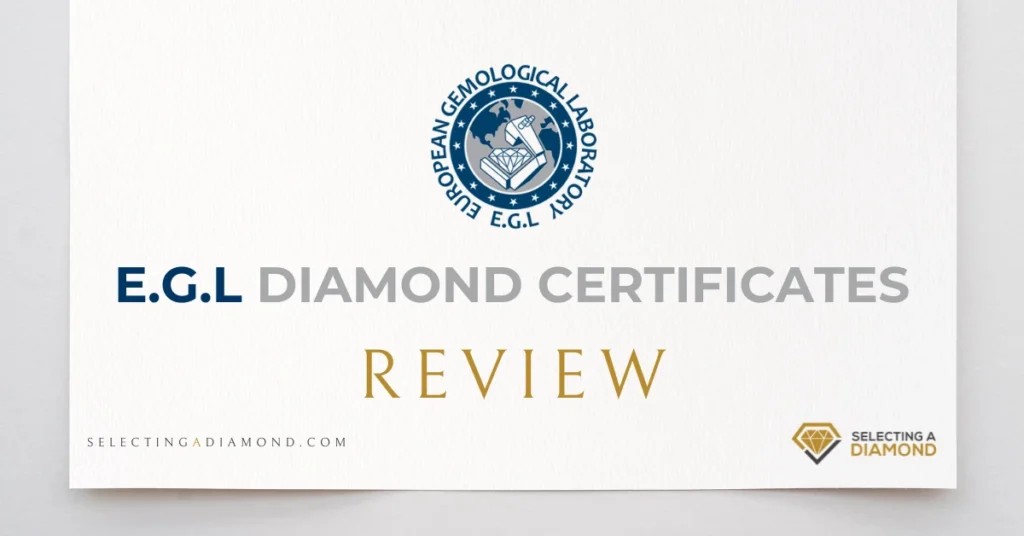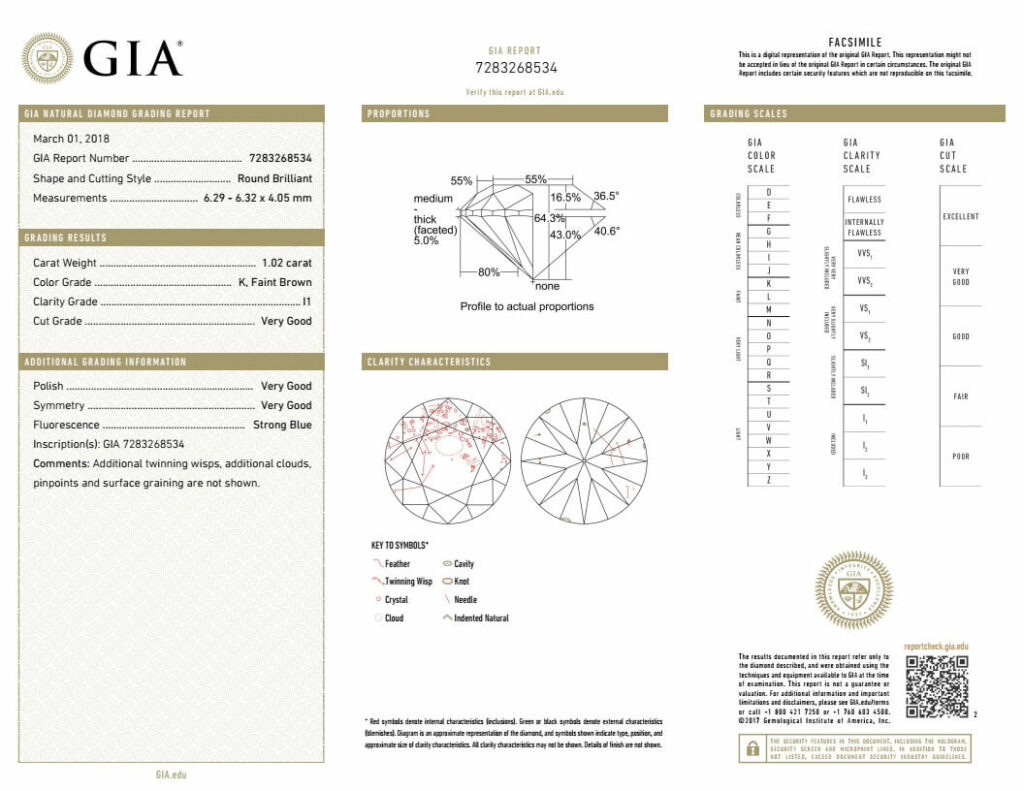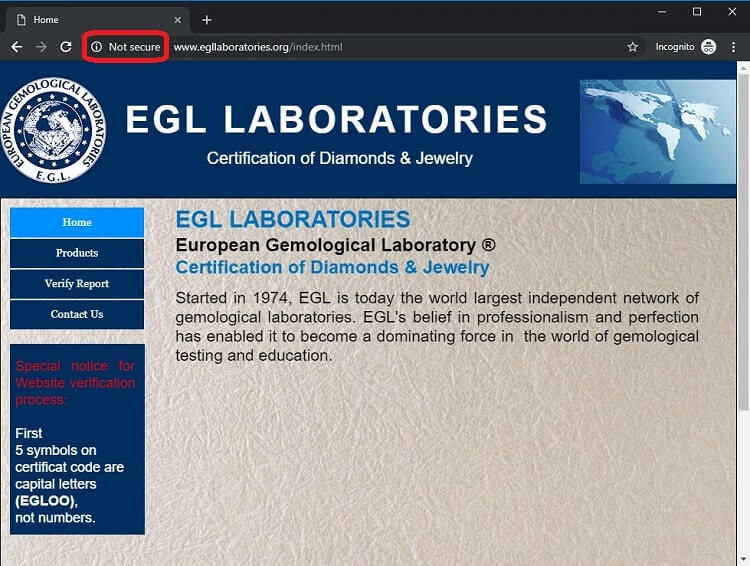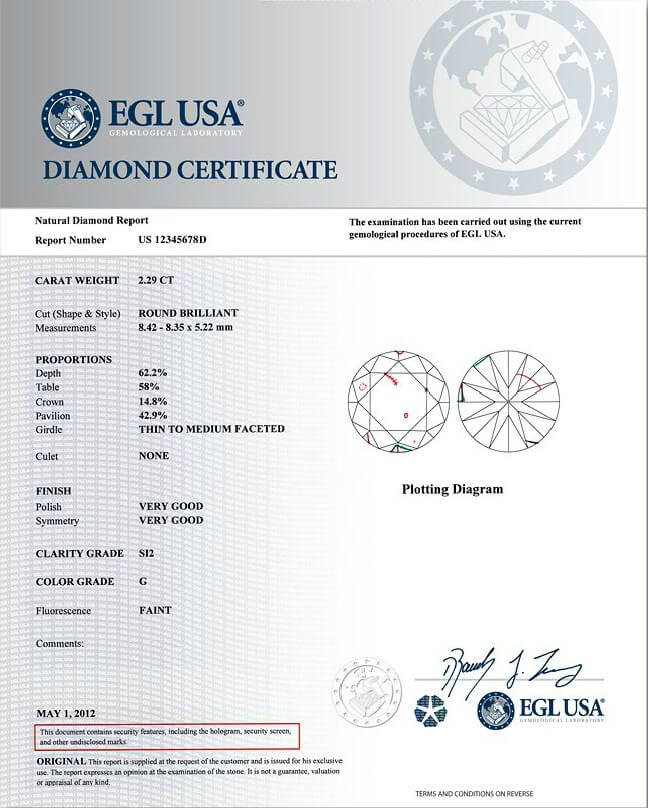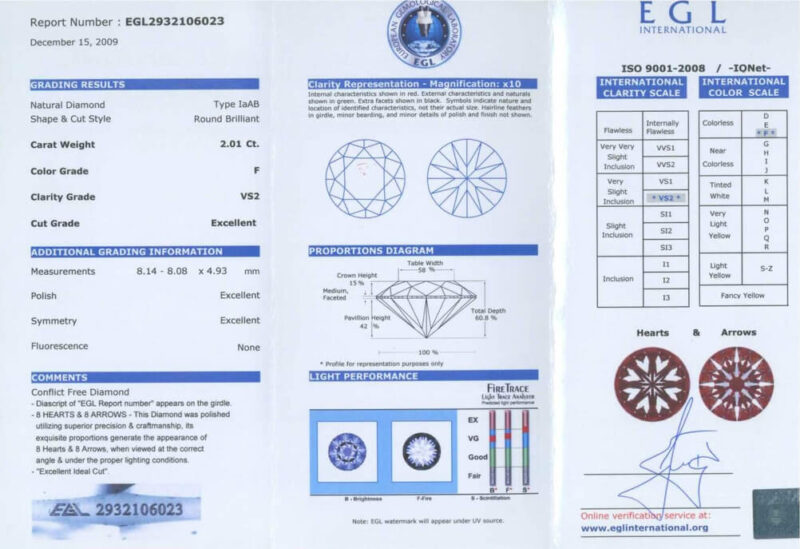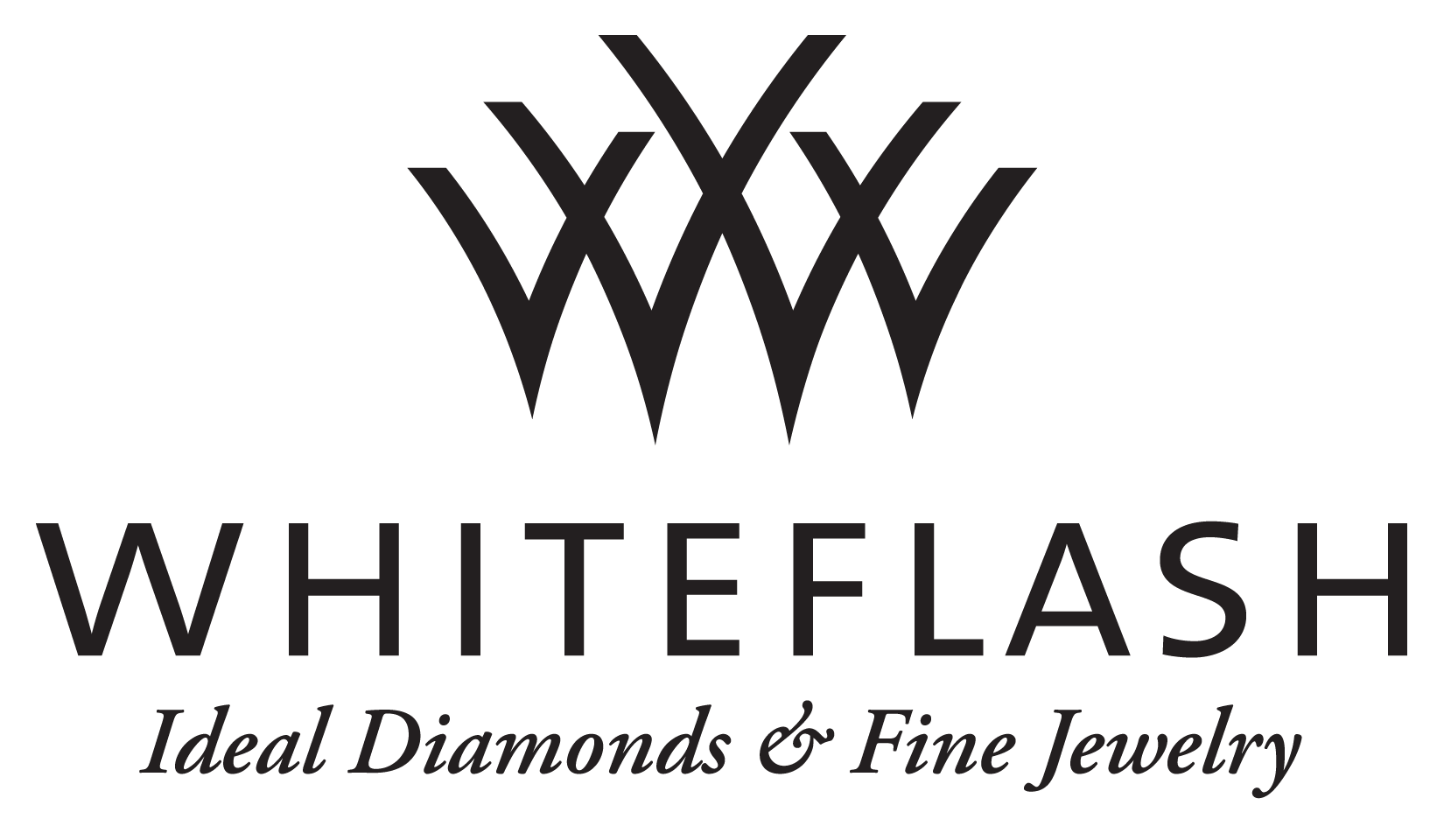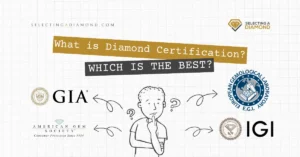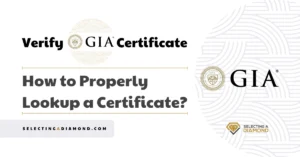We’d love to tell you that we’ve discovered an EGL certificate on one of the highly esteemed retailers we frequently suggest—be it James Allen (synonymous with an unrivaled shopping experience), Blue Nile (boasting the broadest selection of diamonds), or Whiteflash (renowned for premium quality diamonds).
Unfortunately, however, among the hundreds of thousands of diamonds, none of them carry an EGL certification.
There are many laboratories out there that we’re either familiar with or have heard of; some are likely inexperienced, and yet, a few are commendable, adhering to rigorous protocols and scientific methodologies when grading diamonds. However, some are merely neophytes in the industry or, worse, fraudulent!
The primary concern with these types of labs is their inconsistency in grading.
For instance, a lower-tier lab (yes, we’re referring to EGL) might grade a diamond as a G color, while GIA would grade the same diamond as an I or J. Consequently, you end up with a diamond that isn’t what you were guided to purchase. You can see the problem here, right?
The aforementioned trio of retailers, each one of them, collaborates with diamond certification labs regularly. Not just any labs, though, only the crème de la crème:
- GIA: Gemological Institute of America.
- AGS: American Gemological Laboratories.
- IGI: International Gemological Institute.
As such, you’ll never encounter an EGL-graded diamond on these platforms.
So, what exactly are Certified Diamonds?
Diamond Grading & Certification
The primary motivation behind launching this blog was to protect you from becoming a victim of deception. Consider this a preventative measure, saving you from this pitfall: purchasing a counterfeit gem at a hefty price, only to later discover that it’s fake!
Just to jog your memory, we are all acquainted with the 4Cs, aren’t we? Cut, Color, Clarity, and Carat weight! Excellent! When a gem company teams up with a laboratory to grade diamonds based on these four characteristics (among others), they are offering what we call “Certified Diamonds”.
The image you see here is a snapshot of a typical certificate that accompanies a diamond. This certificate is issued by a grading lab, in this case, GIA, the most reputable lab:
When you’re on a quest to buy quality, certified diamonds should be your first port of call. With a multitude of fake gems on the market, one must exercise caution when making a selection.
Also, read: Full Review of IGI & their Grading Assessment
What is EGL Diamond Certificate?
EGL, standing for “European Gemological Laboratory,” began in the 1970s with numerous labs around the globe, each equipped with its own unique set of rules and standards for diamond grading. It’s safe to describe EGL as a “franchise” operation, rather than a prestigious lab.
Wait, scratch that! Even franchise businesses adhere meticulously to uniform procedures and standards!
But let’s press pause on that thought for a moment and circle back to it shortly, shall we?
For our European readers, the name EGL may be more familiar to you than to those residing in the US, since EGL enjoys a higher profile in Europe. Even though it has two institutes in the US—the EGL USA and EGL International—it remains more ubiquitous across Europe.
EGL purports to employ over a thousand scientists and graders in their labs worldwide. The problem is, we struggle to find a single credible resource to glean more information about the company. You’ll find a website for EGL USA, another for Israel, another for India, but no definitive reference site (an official website, we mean).
There is a website claiming to be their official one, but its antiquated appearance—akin to a 1995 throwback—does not inspire confidence, particularly as it lacks any substantive information.
Although some EGL labs have a better reputation than others (for example, EGL NY is often preferred over EGL Israel), it’s generally acknowledged that the EGL grading system as a whole tends to be less rigorous than those of GIA or AGS. That’s just the way it is!
Quick Overview on EGL Diamond Grading System
You’re likely familiar with the SI grades, namely SI1 & SI2, but have you ever come across SI3?
This novel grade was first introduced by EGL in a rather interesting move. Instead of marking a diamond with an I1 (included) grade—which nobody would touch with a ten-foot pole—they invented this grade to make it seem like a step up on the SI scale!
We generally advise against going lower than SI1 because visible inclusions aren’t exactly desirable features in a diamond. So why would such a grade even exist?
The simple answer is that this grade benefits the sellers, not the buyers. For a more detailed comparison, check out our EGL vs. GIA guide.
In the days before diamond inspection tools became advanced, one aspect that set EGL apart was their ability to generate a diamond certificate within 72 hours of receiving a diamond. This efficiency catapulted them to fame as one of the fastest diamond graders in the world!
While this was seen as an advantage for EGL, does it actually make sense?
Absolutely not! Diamond grading shouldn’t be a race against the clock. It isn’t simply a matter of giving it a once-over and grading it on the spot. For a certificate to be reliable, diamonds must undergo a thorough inspection process using high-quality tools and expert analysis, followed by a comparison with diamonds of known grades to ascertain a final grade.
We have our doubts that this process could be completed in just 72 hours! (At least, that was the case back then).
In recent years, the tools and methodologies employed by GIA and AGS to inspect and analyze diamonds have come a long way, making it possible for you to receive a report on the day of submission. This was a far cry from the times when EGL purportedly churned out reports in just 2 or 3 days.
Why Are There Multiple EGL Labs?
Unlike GIA or AGS, EGL is a for-profit company that was established in Europe in 1974. Since then, many other independent labs bearing the same parent company name have sprung up in various locations.
Each lab operates differently from the others, and some are known to adhere to slightly stricter protocols. As such, an EGL certificate for a diamond issued by EGL Israel is considerably less reliable (and distinct) than a certificate issued by EGL New York for the same diamond.
Generally speaking, the EGL labs in NY and LA have a better reputation than other EGL labs (Europe, Israel, South Africa, India, you name it). However, an EGL certificate will generally assign higher grades (especially in terms of Color & Clarity) to a diamond compared to a GIA certificate.
Overview & Review of EGL Diamonds Labs
Being candid without drawing comparisons to other labs such as AGS or GIA (a comparison that might not be fair), let’s focus on the EGL website (the original one; yes, we found it). Here’s a screenshot:
The first thing you’ll notice is that the website seems like a relic from the 1990s—it appears untouched for decades (we’ll gloss over the glaring typo in the bottom left notice; we’re not here to play grammar police).
Secondly, the website’s last update was in 2014:
Thirdly, they didn’t even deem it necessary to install a free browser certificate (to use HTTPS), as evident from the “Not Secure” warning in Chrome (although they managed to obtain a free one later).
Fourthly, let’s see what Google has to say about this site:
SelectingaDiamond.com: Google, how many pages does this site have?
Google:
The upshot is that this site consists of a meager 4 pages, while, in contrast, GIA has approximately 45,000 pages on their website and AGS boasts 6,500.
We also attempted a similar search with the EGL India site, which yielded similarly uninspiring results. Interestingly, out of all the reputable diamond labs, EGL is the sole one lacking a Wikipedia page. Intriguing, right?
When you search for diamonds on trusted sites like James Allen, Whiteflash, or Blue Nile, you’ll NEVER encounter any diamonds with EGL certificates. Now you know why!
EGL Certificate Sample
Like all other certification labs, EGL has its own unique certificate (or multiple certificates as we’ll see shortly), each with its own layout design and details. Here’s a sample of a full diamond report issued by EGL USA:
Next, we have another report issued by EGL International. As you can see, each lab has its own report style, which can admittedly make it a bit more challenging to authenticate a report:
Types of EGL USA Diamond Certificates
The USA “branch” enjoys a slightly better reputation than other branches, so let’s take a closer look at the different types of diamond grading reports they provide at EGL USA:
- EGL USA Diamond Certificate: This certificate is issued following an analysis of a diamond to evaluate and certify the color, clarity, carat weight, cut, and inclusions of any diamond received by their laboratory.
- EGL USA Diamond Analysis Report: This report is generated solely for the analysis of round diamonds. It’s also known as the “Cut Grade diamond” report. It includes carat weight, clarity grade (from FL to I), color grade, cut (shape and style), cut grade, finish, fluorescence, and plotting. The report comes in various formats.
- EGL USA Colored Diamond Report: This certificate, exclusive to EGL USA, is perhaps the most popular document issued for colored diamonds. It highlights the unique characteristics exhibited only by a colored diamond.
- EGL USA Colored Diamond Origin Report: This certificate provides a detailed account of the origin of colored diamonds. It includes a comprehensive description of the color foundations (whether natural, enhanced, or high pressure and high temperature (HPHT) treated.)
- EGL USA Envira Diamond Report: This report combines the typical elements of any diamond report with a pledge towards environmental and social responsibility. It specifies the sustainable, environmentally friendly source of the diamond, and, when relevant, its associated jewelry materials.
The reports are typically issued for heirlooms, reclaimed rare items, and newly mined diamonds, confirming if they are conflict-free and ethically sourced. - EGL USA 360 Diamond Report: This report acts as a technical sheet, offering information about the technical specifics of a diamond. It utilizes twelve criteria and cutting-edge light performance evaluations, including table and depth percentages, pavilion angle, crown angle and height, culet size, girdle thickness, finish, brilliance, contrast, and radiance.
- EGL USA Lab-Grown Diamond Report: This certificate is granted for man-made diamonds, known as lab-grown diamonds or synthetic stones. Despite these diamonds possessing the same chemical, physical, and optical properties as natural diamonds, lab evaluations will reveal them as HPHT, i.e., made by high pressure and high temperature. The report includes a section titled “Lab-Grown Identification,” detailing a report from the laser inscription done on the diamonds.
- EGL USA Hearts and Arrows Diamond Report: This certificate documents the precise cut and unique facet pattern of hearts and arrows diamonds, akin to James Allen’s TrueHearts™ and Blue Nile’s Astor collection. The document outlines the signature design—a circle of hearts viewed through the stone’s pavilion and arrows visible through its crown.
Buying an EGL Certified Diamond, a Good Idea?
It’s important to emphasize that the problem isn’t necessarily with the diamond itself, irrespective of the lab that certified it. In other words, a diamond certified by EGL may well be an excellent one. The real issue is accurately assessing its properties!
If you’re seeking a colorless diamond (graded D, E, or F color) and clarity of VVS1 or VVS2, you might find a GIA-certified stone for about $8,000, while a diamond with the same characteristics listed on an EGL report might cost less than $6,000.
Why the discrepancy?
Because the diamond’s actual qualities are likely to be lower than the EGL report indicates. You might end up with a J or I color diamond with SI1 or VS2 clarity if you were to have it verified by GIA.
Conversely, if you want an SI1 & J color diamond, you could search for an EGL-graded diamond with grades 3 levels higher, although we wouldn’t necessarily recommend that approach.
EGL Certified Diamonds Review Summary
After discussing EGL diamond certificates in depth, you’ve likely formed your own opinion. But just to be clear, here are a few final words of advice:
NEVER purchase a diamond that’s solely EGL certified.
Always opt for GIA or AGS certificates. GIA is generally recognized as the best diamond grading lab.
Buying an EGL diamond may result in overpaying for a stone that’s not worth the price.
There’s a reason why leading online retailers like JamesAllen and Blue Nile don’t list any EGL diamonds on their websites. They choose to stick with the most trusted and reliable grading labs to assure the quality of the diamonds they sell.
Still not sure where to buy your diamond?
We always recommend shopping diamonds online and created a Full guide to shop diamonds like a Pro.
Among online retailers, here are our favorite stores click their logo to visit store
-
James Allen:
Our favorite online store, best diamond imaging technology available today, comes with the largest collection with more than half a million loose diamonds.
-
Blue Nile:
Widest collection of loose diamonds of all sizes, great imaging technology for most of their inventory (hundreds of thousands of diamonds), great customer support.
-
Whiteflash:
Home Of A CUT ABOVE® Super Ideal Diamonds, they stand out from the crowd by offering premium diamonds cuts, tailored to those who love the details, at great prices too.

